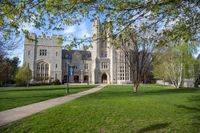In the latest U.S. News & World Report rankings released on April 8, 2025, the landscape of law schools has shifted significantly, with both Yale and Stanford universities maintaining their positions at the top. However, the rankings reveal notable changes for several other institutions, including the University of Connecticut School of Law, which has made impressive strides.
UConn School of Law has climbed five spots to rank 50th overall, a testament to its commitment to educational excellence and student success. Dean Eboni S. Nelson expressed pride in the faculty, staff, students, and alumni who contribute to the school’s achievements. "At UConn Law, our dedication to excellence is unwavering, and we work diligently to ensure the success of our students and institution," she stated. The part-time Evening Division program at UConn Law is particularly noteworthy, now ranked seventh in the nation, up from tenth last year.
The employment outcomes and bar passage rates at UConn Law have also been recognized as strong points. Approximately 96 percent of the Class of 2023 found employment or continued their studies within ten months of graduation. Impressively, among those who took the Connecticut bar exam for the first time in July 2023, 84 percent passed, which is 17 points above the state average. The Class of 2024 is on a similar trajectory, with an 85 percent first-time bar passage rate and 93 percent employed or pursuing further studies after graduation.
As the rankings highlight the competitive nature of law schools, Harvard Law School and Duke University School of Law have both fallen out of the top five, now tied for sixth place. This is a significant drop for both institutions, which have traditionally been fixtures in the upper echelon of law schools. The University of Pennsylvania's Carey Law School has also seen a slight decline, dropping to fifth place.
Meanwhile, Stanford Law School and Yale Law School have retained their spots at the top, reaffirming their status as leaders in legal education. The University of Chicago Law School and the University of Virginia School of Law held steady at third and fourth, respectively. The New York University School of Law and the University of Michigan Law School both moved up one spot to tie for eighth place, while the University of California, Los Angeles School of Law gained one position to land at twelfth.
Interestingly, the latest rankings also show that Vanderbilt University has made the most significant gain among the top 14 law schools, moving up five spots to reach a tie at 14th with Georgetown University Law Center, the University of Texas School of Law, and Washington University in St. Louis School of Law. Conversely, Cornell University’s law school has experienced the largest decline, dropping four spots to 18th, thus falling out of the T-14, a term commonly used to refer to the top law schools in the country.
These shifts come amid increasing scrutiny of the U.S. News rankings methodology, which has undergone changes in recent years. Critics argue that the rankings can create volatility, especially among top schools that often have very similar outcomes in terms of employment and bar passage rates. Derek Muller, a law professor at Notre Dame, noted that small fluctuations in these metrics can lead to larger shifts in rankings.
Moreover, a recent survey conducted by Kaplan shows that 62 percent of law school admissions officers believe that the U.S. News rankings have lost some of their prestige over the last couple of years, a notable increase from 51 percent in 2023. This sentiment reflects a growing concern within the legal education community about the impact of rankings on student recruitment and institutional reputation.
Despite the criticisms, the rankings continue to play a significant role in shaping the choices of prospective law students. A Kaplan survey of 306 pre-law students revealed that only 26 percent thought it would be a positive development for both law schools and applicants to eliminate rankings altogether. This indicates that many students still find value in the information provided by these rankings when deciding where to apply.
The current surge in law school applicants—up 20 percent compared to the previous admissions cycle—may be influenced by various factors, including economic uncertainties and a heightened interest in careers related to politics and public policy. Amit Schlesinger, executive director of legal and government programs at Kaplan, emphasized the intense pressure surrounding law school rankings, noting that they can significantly affect student recruitment and alumni donations.
While some law schools have withdrawn from participating in the rankings process, the majority still engage, highlighting the rankings' enduring influence. Schlesinger advises prospective students to focus on finding law schools that align with their personal and professional goals rather than solely relying on rankings.
As the legal education landscape continues to evolve, the implications of these rankings will likely remain a topic of discussion among educators, students, and legal professionals alike. The U.S. News & World Report rankings, while influential, are just one piece of the puzzle in understanding the complexities of law school admissions and the broader implications for the legal profession.






